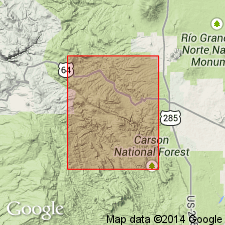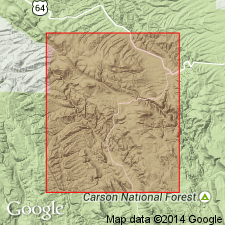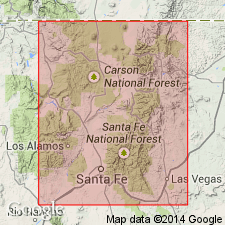
- Usage in publication:
-
- Burned Mountain metarhyolite
- Modifications:
-
- Original reference
- Dominant lithology:
-
- Rhyolite
- AAPG geologic province:
-
- Southern Rocky Mountain region
Summary:
p. 14, 54-56, pl. 1. Burned Mountain metarhyolite. Ranges from brick red to light pink but generally is reddish orange; relict, commonly drag-folded flow bands clearly visible in most outcrops. Intruded older Moppin metavolcanics (new) as sills and dikes; possibly some small flows. The layers of metarbyolite almost everywhere concordant with underlying and overlying strata. Previously called Vallecitos rhyolite [Just, 1937], but here renamed because the earlier name was preempted. Age is Precambrian.
Named from exposures on northwest side of Burned Mountain, in sec. 8, T. 28 N., R. 7 E., [Burned Mountain 7.5-min quadrangle, Rio Arriba Co., Carson National Forest area], central northern NM.
[Notable exposures in Carson National Forest area, Rio Arriba Co.: on Mesa de la Jarita, Las Tablas 7.5-min quadrangle; in Canada del Oso and La Jara Canyon, and along Vallecitos Canyon near Canada Escondida, Canon Plaza 7.5-min quadrangle; and in areas immediately south of Jawbone Mountain near head of Buckhorn Canyon, Burned Mountain 7.5-min quadrangle; in Las Tablas quadrangle and in area immediately to the south.]
Source: US geologic names lexicon (USGS Bull. 1200, p. 544).

- Usage in publication:
-
- Burned Mountain Metarhyolite
- Modifications:
-
- Geochronologic dating
- AAPG geologic province:
-
- Southern Rocky Mountain region
Summary:
Has a radiometric age of 1725-1775 m.y. [corrected in Wobus, 1985 for revised U-Pb constants]. Present in Tusas Mountains, Rio Arriba Co, NM, Southern Rocky Mountain region.
Source: GNU records (USGS DDS-6; Denver GNULEX).

- Usage in publication:
-
- Burned Mountain Metarhyolite*
- Modifications:
-
- Revised
- AAPG geologic province:
-
- Southern Rocky Mountain region
Summary:
Pg. 4, 7, 14, 15, 16 (table 1), 17. Burned Mountain Metarhyolite. Revised to include Barker's (1958, 1970): (1) †informal lower quartzite member of †Kiawa Mountain Formation (abandoned), consists largely of altered metarhyolite (flows and tuffs) with intercalated volcaniclastic sedimentary rocks, such as feldspathic sandstones; (2) the Big Rock Conglomerate Member, transferred from †Kiawa Mountain; and (3) the felsic metavolcanic rocks he mapped as †Petaca Schist (abandoned). [Thickness __.] Locally interlayered with Moppin Metavolcanics, the oldest Precambrian rocks of area (previously the Ortega Quartzite was considered oldest). Age is Early Proterozoic; radiometric age is 1,725 to 1,775 Ma (citing Silver, IN Barker and Friedman, 1974, NM Geol. Soc. Gdbk., no. 25; with corrections for revised U-Pb decay constants).
Source: Publication.

- Usage in publication:
-
- Burned Mountain Formation
- Modifications:
-
- Revised
- Redefined
- AAPG geologic province:
-
- Southern Rocky Mountain region
Summary:
Pg. 46 (table 1), 49. Burned Mountain Formation of Vadito Group. Recognized in the Tusas Mountains of central northern New Mexico. Previously called Burned Mountain Metarhyolite (citing Barker, 1958); changed name since the quartz-eye-bearing metamorphosed rhyolites are only a relatively minor part. Is a massive quartz-feldspar rock characterized by distinctive quartz and feldspar eyes in a fine-grained, laminated matrix. Thickness 15 to 100 feet (4.5 to 30 m). Excludes the Big Rock (raised to formation rank). Age is Early Proterozoic; U-Pb zircon ages indicate ca. 1,700 Ma (citing L.T. Silver, personal commun., 1984).
Source: Publication.
For more information, please contact Nancy Stamm, Geologic Names Committee Secretary.
Asterisk (*) indicates published by U.S. Geological Survey authors.
"No current usage" (†) implies that a name has been abandoned or has fallen into disuse. Former usage and, if known, replacement name given in parentheses ( ).
Slash (/) indicates name conflicts with nomenclatural guidelines (CSN, 1933; ACSN, 1961, 1970; NACSN, 1983, 2005, 2021). May be explained within brackets ([ ]).

